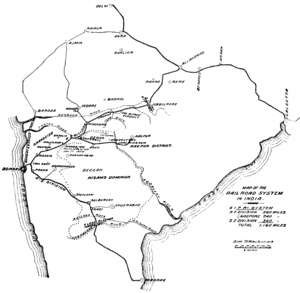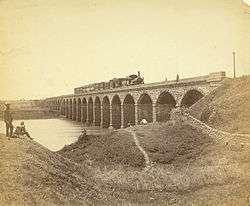Howrah–Allahabad–Mumbai line
| Howrah–Allahabad–Mumbai line | |
|---|---|
| Overview | |
| System | Partly electrified |
| Status | Operational |
| Locale |
West Bengal, Jharkhand, Bihar, Uttar Pradesh, Madhya Pradesh, Maharashtra |
| Termini |
Howrah Station Mumbai CST |
| Operation | |
| Opened | 1870 |
| Owner | Indian Railway |
| Operator(s) | Eastern Railway, East Central Railway, Central Railway |
| Technical | |
| Line length | 2,127 km (1,322 mi) |
| Number of tracks | 2 |
| Track gauge | 1,676 mm (5 ft 6 in) |
| Electrification | Electrified between Mumbai CST–Itarsi and between Allahabad/Cheeoki–Howrah |
| Operating speed | up to 160 km/h (99 mph) |

Howrah–Allahabad–Mumbai line | |||||||||||||||||||||||||||||||||||||||||||||||||||||||||||||||||||||||||||||||||||||||||||||||||||||||||||||||||||||||||||||||||||||||||||||||||||||||||||||||||||||||||||||||||||||||||||||||||||||||||||||||||||||||||||||||||||||||||||||||||||||||||||||||||||||||||||||||||||||||||||||||||||||||||||||||||||||||||||||||||||||||||||||||||||||||||||||||||||||||||||||||||||||||||||||||||||||||||||||||||||||||||||||||||||||||||||||||||||||||||||||||||||||||||||||||||||||||||||||||||||||||||||||||||||||||||||||||||||||||||||||||||||||||||||||||||||||||||||||||||||||||||||||||||||||||||||||||||||||||||||||||||||||||||||||||||||||||||||||||||||||||||||||||||||||||||||||||||||||||||||||||||||||||||||||||||||||||||||||||||||||||||||||||||||||||||||||||||||||||||||||||||||||||||||||||||||||||||||||||||||||||||||||||||||||||||||||||||||||||||||||||||||||||||||||||||||||||||||||||||||||||||||||||||||||||||||||||||||||||||||||
|---|---|---|---|---|---|---|---|---|---|---|---|---|---|---|---|---|---|---|---|---|---|---|---|---|---|---|---|---|---|---|---|---|---|---|---|---|---|---|---|---|---|---|---|---|---|---|---|---|---|---|---|---|---|---|---|---|---|---|---|---|---|---|---|---|---|---|---|---|---|---|---|---|---|---|---|---|---|---|---|---|---|---|---|---|---|---|---|---|---|---|---|---|---|---|---|---|---|---|---|---|---|---|---|---|---|---|---|---|---|---|---|---|---|---|---|---|---|---|---|---|---|---|---|---|---|---|---|---|---|---|---|---|---|---|---|---|---|---|---|---|---|---|---|---|---|---|---|---|---|---|---|---|---|---|---|---|---|---|---|---|---|---|---|---|---|---|---|---|---|---|---|---|---|---|---|---|---|---|---|---|---|---|---|---|---|---|---|---|---|---|---|---|---|---|---|---|---|---|---|---|---|---|---|---|---|---|---|---|---|---|---|---|---|---|---|---|---|---|---|---|---|---|---|---|---|---|---|---|---|---|---|---|---|---|---|---|---|---|---|---|---|---|---|---|---|---|---|---|---|---|---|---|---|---|---|---|---|---|---|---|---|---|---|---|---|---|---|---|---|---|---|---|---|---|---|---|---|---|---|---|---|---|---|---|---|---|---|---|---|---|---|---|---|---|---|---|---|---|---|---|---|---|---|---|---|---|---|---|---|---|---|---|---|---|---|---|---|---|---|---|---|---|---|---|---|---|---|---|---|---|---|---|---|---|---|---|---|---|---|---|---|---|---|---|---|---|---|---|---|---|---|---|---|---|---|---|---|---|---|---|---|---|---|---|---|---|---|---|---|---|---|---|---|---|---|---|---|---|---|---|---|---|---|---|---|---|---|---|---|---|---|---|---|---|---|---|---|---|---|---|---|---|---|---|---|---|---|---|---|---|---|---|---|---|---|---|---|---|---|---|---|---|---|---|---|---|---|---|---|---|---|---|---|---|---|---|---|---|---|---|---|---|---|---|---|---|---|---|---|---|---|---|---|---|---|---|---|---|---|---|---|---|---|---|---|---|---|---|---|---|---|---|---|---|---|---|---|---|---|---|---|---|---|---|---|---|---|---|---|---|---|---|---|---|---|---|---|---|---|---|---|---|---|---|---|---|---|---|---|---|---|---|---|---|---|---|---|---|---|---|---|---|---|---|---|---|---|---|---|---|---|---|---|---|---|---|---|---|---|---|---|---|---|---|---|---|---|---|---|---|---|---|---|---|---|---|---|---|---|---|---|---|---|---|---|---|---|---|---|---|---|---|---|---|---|---|---|---|---|---|---|---|---|---|---|---|---|---|---|---|---|---|---|---|---|---|---|---|---|---|---|---|---|---|---|---|---|---|---|---|---|---|---|---|---|---|---|---|---|---|---|---|---|---|---|---|---|---|---|---|---|---|---|---|---|---|---|---|---|---|---|---|---|---|---|---|---|---|---|---|---|---|---|---|---|---|---|---|---|---|---|---|---|---|---|---|---|---|---|---|---|---|---|---|---|---|---|---|---|---|---|---|---|---|---|---|---|---|---|---|---|---|---|---|---|---|---|---|---|---|---|---|---|---|---|---|---|---|---|---|---|---|---|---|---|---|---|---|---|---|---|---|---|---|---|---|---|---|---|---|---|---|---|---|---|---|---|---|---|---|---|---|---|---|---|---|---|---|---|---|---|---|---|---|---|---|---|---|---|---|---|---|---|---|---|---|---|---|---|---|---|---|---|---|---|---|---|---|---|---|---|---|---|---|---|---|---|---|---|---|---|---|---|---|---|---|---|---|---|---|---|---|---|---|---|---|---|---|---|---|---|---|---|---|---|---|---|---|---|---|---|---|---|---|---|---|---|---|---|---|---|---|---|---|---|---|---|---|---|---|---|---|---|---|---|---|---|---|---|---|---|---|---|---|---|---|---|---|---|---|---|---|---|---|---|---|---|---|---|---|---|---|---|---|---|---|---|---|---|---|---|---|---|---|---|---|---|---|---|---|---|---|---|---|---|---|---|---|---|---|---|---|---|---|---|---|---|---|---|---|---|---|---|---|---|---|---|---|---|---|---|---|---|---|---|
Legend
Source: Indian Railway Time Table | |||||||||||||||||||||||||||||||||||||||||||||||||||||||||||||||||||||||||||||||||||||||||||||||||||||||||||||||||||||||||||||||||||||||||||||||||||||||||||||||||||||||||||||||||||||||||||||||||||||||||||||||||||||||||||||||||||||||||||||||||||||||||||||||||||||||||||||||||||||||||||||||||||||||||||||||||||||||||||||||||||||||||||||||||||||||||||||||||||||||||||||||||||||||||||||||||||||||||||||||||||||||||||||||||||||||||||||||||||||||||||||||||||||||||||||||||||||||||||||||||||||||||||||||||||||||||||||||||||||||||||||||||||||||||||||||||||||||||||||||||||||||||||||||||||||||||||||||||||||||||||||||||||||||||||||||||||||||||||||||||||||||||||||||||||||||||||||||||||||||||||||||||||||||||||||||||||||||||||||||||||||||||||||||||||||||||||||||||||||||||||||||||||||||||||||||||||||||||||||||||||||||||||||||||||||||||||||||||||||||||||||||||||||||||||||||||||||||||||||||||||||||||||||||||||||||||||||||||||||||||||||
The Howrah–Allahabad–Mumbai line is a railway line connecting Kolkata and Mumbai via Allahabad. The 2,127-kilometre long (1,322 mi) railway line was opened to traffic in 1870.
Sections
For more detailed study the cross-country line has been divided into smaller sections:
- Howrah-Bardhaman chord
- Bardhaman-Asansol section
- Asansol-Gaya section
- Gaya-Mughalsarai section
- Mughalsarai-Allahabad section
- Allahabad-Jabalpur section
- Jabalpur-Bhusaval section
- Bhusawal-Kalyan section
- Kalyan-Mumbai CST section
History
The first train in India traveled from Bombay to Thane on 16 April 1853. By May 1854, Great Indian Peninsula Railway's Bombay-Thane line was extended to Kalyan. It was extended to Khopoli via Palasdhari in 1855. Bhusawal station was set up in 1860 and Pune connected in 1863. In Eastern India, construction of the Howrah-Delhi main line was completed and through connection between Delhi and Kolkata was established in 1865. The last link was the bridge across the Yamuna at Allahabad. In 1866 Bhusawal-Khandwa section was opened and GIPR also extended its operations to Nagpur. East Indian Railway, which had established the Howrah-Allahabad-Delhi line, opened the Allahabad-Jabalpur branch line in June 1867. GIPR connection over the Thull Ghat reached Jabalpur from Itarsi on 7 March 1870, linking up with EIR track there from Allahabad, and establishing connectivity between Mumbai and Kolkata.[1][2]
The Bengal Nagpur Railway was formed in 1887 for the purpose of upgrading the Nagpur Chhattisgarh Railway and then extending it via Bilaspur to Asansol, in order to develop a shorter Howrah-Mumbai route than the one via Allahabad.[3] The Bengal Nagpur Railway main line from Nagpur to Asansol, on the Howrah-Delhi main line, was opened for goods traffic on 1 February 1891.[4] It was only after Kharagpur was linked from the west and the south that it was connected to Howrah in 1900.
The opening of this track was part of the inspiration for the French writer Jules Verne's book "Around the World in Eighty Days." At the opening ceremony, the Viceroy Lord Mayo concluded that "it was thought desirable that, if possible, at the earliest possible moment, the whole country should be covered with a network of lines in a uniform system."
Electrification
In August 1976, the New Delhi–Howrah route (via Grand Chord), and that includes the Howrah-Allahabad section of the Howrah–Allahabad–Mumbai line, was the first trunk route in the country to be completely electrified with AC traction. The stretch between Mumbai CST and Itarsi on Mumbai-Allahabad-Howrah line is also completely electrified. The stretch between Itarsi and Allahabad is not electrified and work is on progress to electrify this section.
Speed limits
Most of the Howrah-Gaya-Delhi line and Howrah-Bardhaman Chord (the line is common with this line up to Allahabad) is classified as 'A' class line where trains can run up to 160 kilometres per hour (99 mph) but in certain sections speeds may be limited to 120–130 kilometres per hour (75–81 mph). The line from Bhusawal to Mumbai is also classified as 'A' class. The Allahabad-Bhusawal sector is classified as 'B' class where trains can run up to 130 km/h.[5]
Calcutta Mail
The Imperial Indian Mail (now called Howrah-Mumbai Mail via Allahabad), running on this route, was possibly the first named train of Indian Railway. The Mumbai-Howrah Mail via Allahabad is called Calcutta Mail between Mumbai and Allahabad, and Mumbai Mail (some still call it by its old name, Bombay Mail) between Allahabad and Howrah. It is of course no match for the famed Imperial Indian Mail of yesteryears.[6][7]
Inspiration for writing
The Kolkata-Mumbai linkage, along with other events, inspired the French writer Jules Verne to write his book Around the World in Eighty Days.[8]
References
- ↑ "IR History: Early Days – I". Chronology of railways in India, Part 2 (1832 - 1865). Retrieved 27 October 2012.
- ↑ "IR History: Early Days – II". Chronology of railways in India, Part 2 (1870 - 1899). Retrieved 27 October 2012.
- ↑ "Number 1 Down Mail". Railways of the Raj. Retrieved 19 February 2012.
- ↑ "Major Events in the Formation of S.E. Railway". South Eastern Railway. Retrieved 19 February 2012.
- ↑ "Permanent Way". Track Classifications. Retrieved 15 January 2012.
- ↑ Dutta, Joydeep. "Trains of fame and locos with a name - Part 1". IRFCA. Retrieved 7 November 2012.
- ↑ "In the footsteps of the Imperial Mail". The Lonely Wanderer. Retrieved 27 May 2013.
- ↑ "Great Indian Peninsula Railway". British Industrial History. Grace’s Guide. Retrieved 2013-03-28.
External links
|
|
